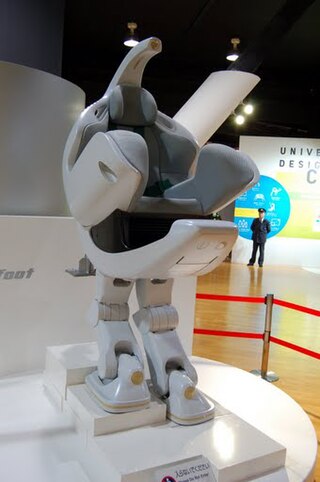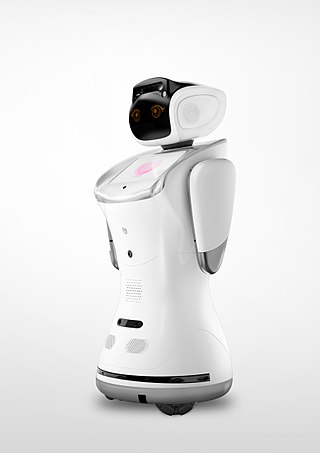Related Research Articles

An android is a humanoid robot or other artificial being often made from a flesh-like material. Historically, androids were completely within the domain of science fiction and frequently seen in film and television, but advances in robot technology now allow the design of functional and realistic humanoid robots.

A robot is a machine—especially one programmable by a computer—capable of carrying out a complex series of actions automatically. A robot can be guided by an external control device, or the control may be embedded within. Robots may be constructed to evoke human form, but most robots are task-performing machines, designed with an emphasis on stark functionality, rather than expressive aesthetics.
AIBO is a series of robotic dogs designed and manufactured by Sony. Sony announced a prototype Aibo in mid-1998, and the first consumer model was introduced on 11 May 1999. New models were released every year until 2006. Although most models were dogs, other inspirations included lion cubs, huskies, Jack Russell terriers, bull terrier, and space explorers. Only the ERS-7, ERS-110/111 and ERS-1000 versions were explicitly a "robotic dog", but the 210 can also be considered a dog due to its Jack Russell Terrier appearance and face. In 2006, AIBO was added into the Carnegie Mellon University Robot Hall of Fame.
An autonomous robot is a robot that acts without recourse to human control. The first autonomous robots environment were known as Elmer and Elsie, which were constructed in the late 1940s by W. Grey Walter. They were the first robots in history that were programmed to "think" the way biological brains do and meant to have free will. Elmer and Elsie were often labeled as tortoises because of how they were shaped and the manner in which they moved. They were capable of phototaxis which is the movement that occurs in response to light stimulus.

A humanoid robot is a robot resembling the human body in shape. The design may be for functional purposes, such as interacting with human tools and environments, for experimental purposes, such as the study of bipedal locomotion, or for other purposes. In general, humanoid robots have a torso, a head, two arms, and two legs, though some humanoid robots may replicate only part of the body, for example, from the waist up. Some humanoid robots also have heads designed to replicate human facial features such as eyes and mouths. Androids are humanoid robots built to aesthetically resemble humans.

ABB Ltd. is a Swedish-Swiss multinational corporation headquartered in Västerås, Sweden, and Zürich, Switzerland. It is traded on the SIX Swiss Exchange in Zürich, the Nasdaq Nordic exchange in Sweden and the OTC Markets Group's pink sheets in the United States. It was ranked 340th in the Fortune Global 500 list of 2020 and has been a global Fortune 500 company for 24 years.

ASIMO is a humanoid robot created by Honda in 2000. It is displayed in the Miraikan museum in Tokyo, Japan. On 8 July 2018, Honda posted the last update of Asimo on their official page stating that it would be ceasing all development and production of Asimo robots in order to focus on more practical applications using the technology developed through Asimo's lifespan. It made its last active appearance in March 2022, over 20 years after its first, as Honda announced that they are retiring the robot to concentrate on remote-controlled, avatar-style, robotic technology.

A robonaut is a humanoid robot, part of a development project conducted by the Dexterous Robotics Laboratory at NASA's Lyndon B. Johnson Space Center (JSC) in Houston, Texas. Robonaut differs from other current space-faring robots in that, while most current space robotic systems are designed to move large objects, Robonaut's tasks require more dexterity.

In Japan, popular robots include humanoid entertainment robots, androids, animal robots, social robots, guard robots, and many more. Each type has a variety of characteristics.
Boston Dynamics is an American engineering and robotics design company founded in 1992 as a spin-off from the Massachusetts Institute of Technology. Headquartered in Waltham, Massachusetts, Boston Dynamics has been owned by the Hyundai Motor Group since December 2020, but having only completed the acquisition in June 2021.

The history of robots has its origins in the ancient world. During the industrial revolution, humans developed the structural engineering capability to control electricity so that machines could be powered with small motors. In the early 20th century, the notion of a humanoid machine was developed.

Robot Operating System is an open-source robotics middleware suite. Although ROS is not an operating system (OS) but a set of software frameworks for robot software development, it provides services designed for a heterogeneous computer cluster such as hardware abstraction, low-level device control, implementation of commonly used functionality, message-passing between processes, and package management. Running sets of ROS-based processes are represented in a graph architecture where processing takes place in nodes that may receive, post, and multiplex sensor data, control, state, planning, actuator, and other messages. Despite the importance of reactivity and low latency in robot control, ROS is not a real-time operating system (RTOS). However, it is possible to integrate ROS with real-time computing code. The lack of support for real-time systems has been addressed in the creation of ROS 2, a major revision of the ROS API which will take advantage of modern libraries and technologies for core ROS functions and add support for real-time code and embedded system hardware.

The Toyota Partner Robots are a series of humanoid robots developed by Toyota. They debuted playing music on drums and trumpets at the 2005 World EXPO in Aichi, Japan. There are 5 robots in all, most of which have different movement systems. The 5 robots are: Version 1, Version 2, Version 3, Version 4 and the i-Foot . In July 2009, Toyota released a video of the running and standing skills of their partner robot. The robot reaches 7 km/hour, however walking and running can only be achieved on flat surfaces. In 2017, Toyota released its third-generation of humanoid robots, T-HR3, which will be used in space travel.

The HRP-4C, nicknamed Miim, is a feminine-looking humanoid robot created by the National Institute of Advanced Industrial Science and Technology (AIST), a Japanese research facility.

Nadine is a gynoid humanoid social robot that is modelled on Professor Nadia Magnenat Thalmann. The robot has a strong human-likeness with a natural-looking skin and hair and realistic hands. Nadine is a socially intelligent robot which returns a greeting, makes eye contact, and can remember all the conversations had with it. It is able to answer questions autonomously in several languages, simulate emotions both in gestures and facially, depending on the content of the interaction with the user. Nadine can recognise persons it has previously seen, and engage in flowing conversation. Nadine has been programmed with a "personality", in that its demeanour can change according to what is said to it. Nadine has a total of 27 degrees of freedom for facial expressions and upper body movements. With persons it has previously encountered, it remembers facts and events related to each person. It can assist people with special needs by reading stories, showing images, put on Skype sessions, send emails, and communicate with other members of the family. It can play the role of a receptionist in an office or be dedicated to be a personal coach.

Sanbot is an intelligent, cloud-enabled service robot developed by Qihan Technology Co. Ltd., a robotics and AI company who has their headquarters in Shenzhen, China. Qihan has launched three generations of intelligent robots under the Sanbot brand – Sanbot Elf Sanbot King Kong and Sanbot Nano.

Sophia is a social humanoid robot developed by the Hong Kong-based company Hanson Robotics. Sophia was activated on February 14, 2016, and made its first public appearance in mid-March 2016 at South by Southwest (SXSW) in Austin, Texas, United States. Sophia is marketed as a "social robot" that can mimic social behavior and induce feelings of love in humans.
Hanson Robotics Limited is a Hong Kong-based engineering and robotics company founded by David Hanson, known for its development of human-like robots with artificial intelligence (AI) for consumer, entertainment, service, healthcare, and research applications. The robots include Albert HUBO, the first walking robot with human-like expressions; BINA48, an interactive humanoid robot bust; and Sophia, the world's first robot citizen. The company has 45 employees.

Ai-Da is a robotic art exhibition created by British artist Aidan Meller, which has been described by its creator as "the world's first ultra-realistic humanoid robot". Completed in 2019, Ai-Da is an android incorporating computer graphics and artificial intelligence algorithms that makes drawings, paintings, and sculptures. It is named after Ada Lovelace.

Robot Shalu is a homemade, artificially intelligent, multilingual, social and educational humanoid robot, made-up of waste materials, that can speak 47 languages, developed by Dinesh Kunwar Patel, a Kendriya Vidyalaya, Computer Science teacher from Mumbai, India. Shalu is recognized in the top ten humanoid robots of the world by Danik Bhaskar, Vaartha, TIME magazine, and Hindustan News. Shalu is also among top 5 trending Indian robots in the global Tech Market.
References
- ↑ "Launch of Hitachi's EMIEW 2 Robot Goes a Bit Awry". Archived from the original on 2008-12-01. Retrieved 2008-10-18.
- 1 2 "BBC NEWS - Technology - Hitachi unveils 'fastest robot'". 16 March 2005. Retrieved 1 March 2017.
- ↑ GLOBAL, HITACHI. "HITACHI GLOBAL : News Release : Hitachi Develops a Robot that has the Capabilities for Daily Life and that Moves in Response to Dialogs with People" . Retrieved 1 March 2017.
- ↑ "Redirect Page : Research & Development : Hitachi". Archived from the original on 2 March 2017. Retrieved 1 March 2017.
- ↑ GLOBAL, HITACHI. "HITACHI GLOBAL : News Release : Hitachi Develops a Robot that has the Capabilities for Daily Life and that Moves in Response to Dialogs with People" . Retrieved 1 March 2017.
- ↑ Hitachi humanoid rolls over floor junk, looks cute